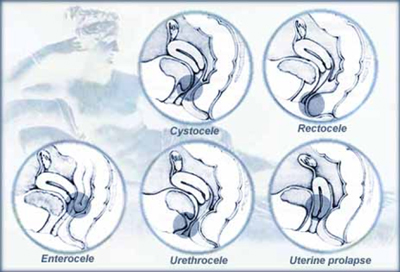Many women suffer unnecessarily from conditions involving pelvic relaxation. If you have any of these symptoms described in this section, contact us at (305) 668-2853 or e-mail us. Appropriate diagnosis and treatment will often restore patients to a life free of the aggravations and discomforts associated with pelvic relaxation.
Menu
Vaginal Relaxation and Urinary Incontinence |
|---|
Thirty million American women suffer from symptoms of vaginal relaxation and stress urinary incontinence. Many women have difficulty controlling their urine in certain situations or notice changes in their bowel habits. These two symptoms may be related to a common set of problems that may occur as a result of childbirth, aging or a combination of both. Grouped together these problems are referred to as pelvic relaxation.
Many women suffer unnecessarily from conditions involving pelvic relaxation. If you have any of these symptoms described in this section, contact us at (305) 668-2853 or e-mail us. Appropriate diagnosis and treatment will often restore patients to a life free of the aggravations and discomforts associated with pelvic relaxation.
The goal is to acquaint you with the various forms of pelvic relaxation as well as their causes, symptoms, and treatment. The pelvic organs include the vagina, uterus, bladder, and rectum. These organs are held in position by three types of supports: 1) muscles, 2) sheets of tissue called fascia 3) and ligaments. When these supports become damaged for various reasons, one or more of the pelvic organs may sag and, occasionally, even protrude outside the vagina. These are called pelvic support defects.

During childbirth, as the baby passes through the birth canal, the muscles, fascia, and ligaments separate and may be weakened. This weakening gradually worsens and, in later years, may cause the pelvic organs to drop from their normal positions.
Occasionally, this weakening of the muscles and tissue may occur in women who have never had children. In these women, the cause may be:
- Inherited weakness of the supporting tissues.
- Unusual strain placed on the supporting tissues by a chronic cough.
- Unusual increases in abdominal pressure.
- Obesity.
The general symptoms associated with pelvic relaxation depend on which organs are affected. Often there is a feeling of heaviness or fullness. Small or moderate amounts of urine may be lost with normal physical activities such as laughing, coughing, walking, or running. In more advanced and rare cases, a mass may actually protrude from the vaginal opening. Based on the organ or organs involved, pelvic support defects can be defined more specifically as:
- Cystocele.
- Urethrocele (most of the time the cystocele and urethrocele occur in combination – cystourethrocele).
Rectocele. - Enterocele.
- Uterine prolapse.
![]() A cystocele occurs when the bladder falls or descends from its normal position. The most common symptom associated with cystocele is difficulty in completely emptying the bladder. This can be associated with bladder infections. Large cystoceles can cause the bladder to overfill and allow small amounts of urine to leak. Leakage is most common during activity such as walking or bouts of coughing.
A cystocele occurs when the bladder falls or descends from its normal position. The most common symptom associated with cystocele is difficulty in completely emptying the bladder. This can be associated with bladder infections. Large cystoceles can cause the bladder to overfill and allow small amounts of urine to leak. Leakage is most common during activity such as walking or bouts of coughing.
- A urethrocele usually occurs in conjunction with a cystocele. Both of these conditions result in, among other things, involuntary loss of urine, particularly when there is increased pressure in the abdomen, caused by walking, jumping, coughing, sneezing, laughing, or sudden movements.
- A rectocele is the bulging of the rectum into or out of the vagina. This usually occurs as a result of injuries sustained during childbirth. With a weakened or bulging rectum, bowel movements become more difficult. .
- An enterocele is the bulging of small intestines into the back wall of the vagina
- Uterine prolapse occurs when the uterus falls or is displaced from its normal position. There are varying degrees of severity depending on the descent. This produces a general felling of heaviness and fullness, or a sense that the uterus is falling out.
The diagnosis of these problems includes a through history and physical examination. Tests may be performed, depending on the circumstances, include a “Q-tip” test (to determine the mobility of the urethra), urodynamic studies (a painless fifteen to twenty minute computerized bladder and urethra functional study), urethrocystoscopy (evaluation of the inside of the bladder and urethra), X-rays of the urinary system.
For all practical purposes, definitive treatment is surgical correction of the specific defects.
Get started here.
Your journey begins right now. Coming this far is the first step to achieving your cosmetic goals and aspirations. Dr. Antun is standing by to begin the conversations that will change your life, build your confidence, and provide you the happiness that comes from looking and feeling your best. Fill out our secure request form below to learn more, or to schedule your consultation in-person, or via FaceTime or Skype with Dr. Rafael Antun. We look forward to understanding your vision further and making your dreams a reality.
get social:
Featured In:





NEED ASSISTANCE?
Visit Us
Laser Vaginal Rejuvenation
Contact
HDEsthetique ©2019 All rights Reserved.
